Claypot Cooking Care
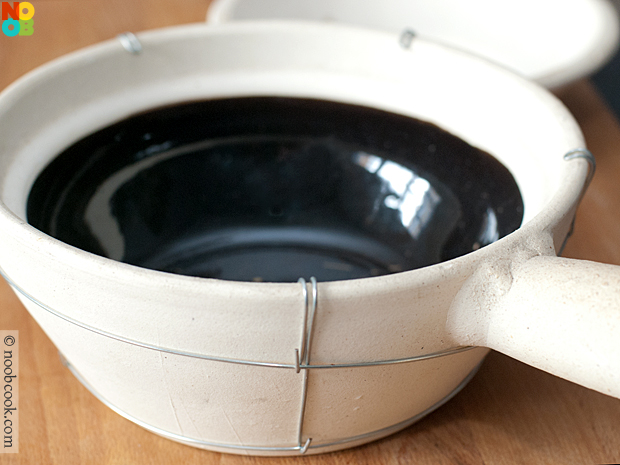
I’m now a huge fan of claypot (砂鍋/ 煲仔) cooking. I fell in love with it ever since I used it for the first time to cook braised chicken with bittergourd, and the most recent claypot dish I cooked – claypot chicken rice – totally impressed me again with the distinctive smoky flavour. In short, everything looks and tastes better when cooked in a claypot. This is a short article about Chinese claypot care as a reference for those who might be interested to venture into claypot cooking too. If you have more tips about claypot cooking, please share them with me at the comments section.
Benefits of clay pot cooking
1. Since the material is porous, it absorbs water. When cooking food, the moisture is released, making the cooked food moist, juicy and tender similar to steaming effect. There is also less evaporation of water and food do not burn so easily.
2. The claypot retains heat well, so it can cook food in a quicker and more effective way. It also keeps the food warm and further slow-cook it, with lid close for at least another half an hour after cooking.
3. You can re-heat and serve the food in the claypot right away.
4. Dishes such as claypot rice have a wonderful earthy and smoky flavour which is distinctive with claypot cooking.
Selecting a claypot

Chinese claypot with glazed interior and coiled wires on the exterior
1. Make sure there are no visible cracks on the wall and the lid can close snugly.
2. Choose a claypot that comes with metal wires along the walls (pictured above) as it helps to conduct heat quickly and evenly throughout the casserole.
How to prep a brand new claypot for first time use
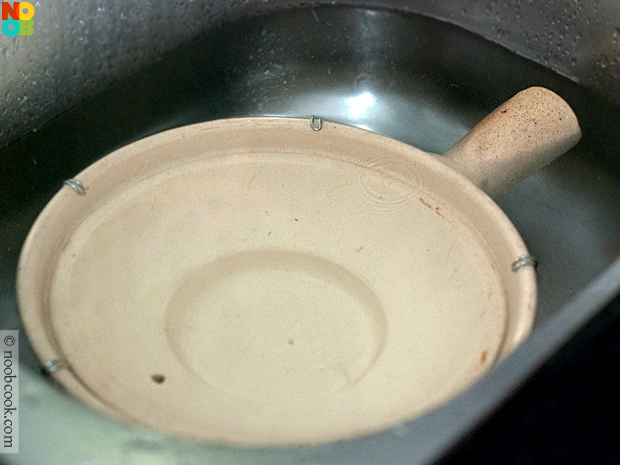
Soaking brand new claypot in water
1. Totally submerge and soak the claypot in water (turn the lid inside out) for at least half an hour (pictured above).
2. If there is any dirt or powder on the claypot, scrub it well with a hard brush or non-metallic scrubbing pad.
3. If you bought the type which is porous throughout (without the glazed interior walls), you can also boil some water or porridge in it after soaking.
4. Leave the claypot at room temperature to air dry, do not use dish washer.
5. For first time cooking in a new claypot, do not cook food with strong flavours such as seafood or curries as the smell may linger on and affect the taste of the other dishes.
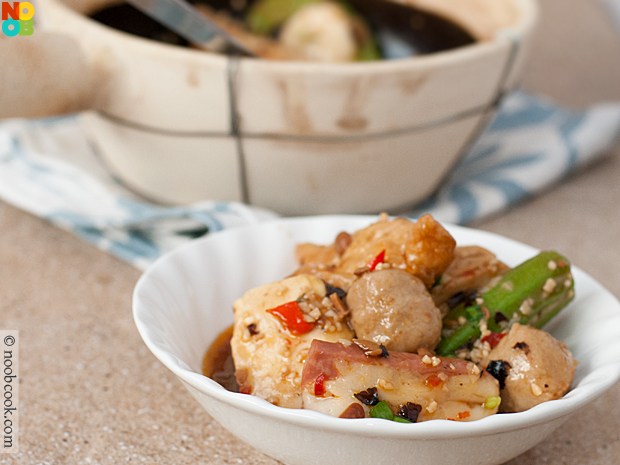
Claypot Yong Tau Foo
Care for clay pot
1. No sudden change in temperature. Claypot can withstand relatively high heat both on the stove top and inside the oven. However, they cannot withstand sudden fluctuations in temperature so always increase heat gradually. Do not put the claypot straight away inside a preheated oven; instead put it inside the cold oven and let it heat up gradually. On stove top, heat the claypot starting with a low medium heat and increase the temperature gradually. If you took the claypot out from the fridge, let it rest and return to room temperature before reheating.
2. Temperature. Since claypot conducts and retains heat well, you generally do not need as high heat as you normally need. You can use lower temperature to cook the same type of food, compared to the heat you normally use when cooking in other types of cookware.
3. Washing. After cooking, use a hard brush or non-metallic scouring pad to scrub. Wash the glazed part of the claypot with mild soapy water. For the unglazed part, do not use detergent as the porous material may absorb it. Instead, use natural cleaning agents such as lemon or vinegar solution.

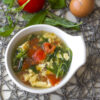




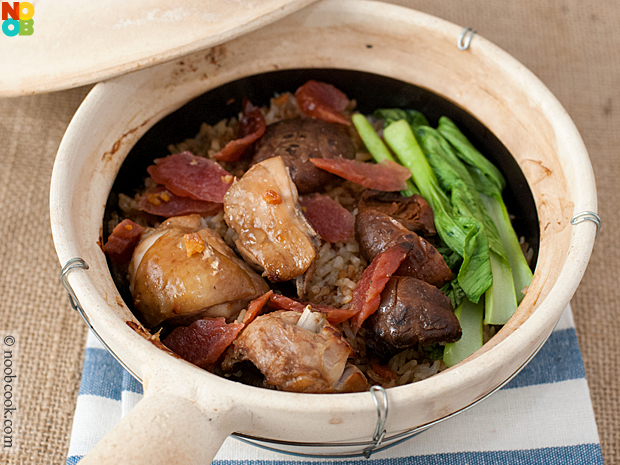






Great tips Wiffy! Makes me want to take out my claypot (which is still new) and whip up a dish this weekend. I do agree that dishes made in a claypot tastes so much better.
Very organized and informative post. Before the first boiling, I also seasoned the outer bottom of the clay pot with oil, and air-dry it, just to share.
Nom nom nom.. that looks absolutely delicious! :)
Wiffy, thanks for the great tips! I don’t own a claypot so appreciate your advice as to where to get one? Estimated cost? Is it difficult to scrub off the burnt rice (which taste so heavenly!)? Michelle
You can find at those old 杂货店 which sells crockery. I got mine at Chinatown, row of shop houses facing Chinatown Complex (the big hawker). I can’t remember how much I got it for, around S$10? So far I did not hear any complaints about the burnt bits being difficult to clean (I am the cook so someone else washes hehe) … I think just soak in water and use a non-metallic scrubbing pad or hard brush.
Wiffy, I am new using clay pots. I had grown seen my mother cooking in them but never knew that I had to cure it before I cook something in it. I am in desparate need of advice. I bought a new claypot, just washed it carefully and let it dry. After a few days I made the traditional sweetened vinager, ginger, and egg soup for my soon baby to come. I noticed a little leak that first time, but did not pay much attention to that. Next time I heated my claypot, I noticed more leaks and a change in color (more dark) of the outside of the claypot. Today, I reheated the soup but could not do it because the bottom of my claypot have a severe leakage and was burning my stovetop. I thought I bought a defective claypot until I began my search and read something about curing first time clay pot.
My question is if there is some remedy for my situation or should I buy a new clay pot and transfer my soup. I had an unglazed claypot in the outside, and it is glazed in the inside.
Thanks for all your help!!
awesome food cook with clay pot,thanks for sharing
You site has interested me in purchasing a clay pot and make some of the dishes that you have posted but as you said above there are glazed and un-glazed clay pots which is better?
I’m personally using a glazed inner pot because that’s what is more common here. And glazed is easier to clean. But if you like 100% claypot cooking, you can go for unglazed. It’s totally your personal choice.
Hi Wiffi,
I am from India.In our country people usually cooked in clay pots in ancient times.Now everyone is using metalic bowls.I want to make people to use clay pot cooking.If you suggest some uses regarding health by using clay pots,I will tell the people and make them, use again
Thanks
Hi
can you help first time using clay pot and I obviously did not use enough liquid and burnt bottom of pot inside can I save it
happened to me too. i used a kinda metal scour to get the burnt stuff off. not sure if it damaged the glaze..
Thanks for the awesome post, this is all the info I need. Just bought one and I’m puuumped